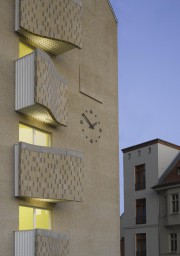Educational Centre in Aschersleben
Since 1912 the centre of the small town of Aschersleben has been dominated by an oversized factory building the locals call the ‘Hecknerriese’ (Heckner’s Giant). The name comes from the man who built it, the architect Hans Heckner, who was able to erect several remarkable buildings in this town right into the 1930s. His idiom is reminiscent of Theodor Fischer’s works and is based on the concept of ‘Weiterbauen’ (continuity), which reflects aspects of today’s architectural discussions.
In recent years the large factory site had degenerated into a vacant lot – until the town decided to demolish part of the factory building, to convert its main section into an educational centre and to add an extension to it. To that end, Aschersleben had announced a competition which was to simultaneously promote the urban restructuring of the entire site with larger open spaces. These were intended to serve as the basis for a planned garden show.
We designed a long building wing extending perpendicularly to the old building, which enabled the creation of a park that bridges the district from south to north. This is the actual linking element between the town’s two large park areas, which could now be united into a continuous greenbelt.
Unfortunately, the concept of uniting three sorts of school in one structure could not be completely realised. During the planning and building, this situation led to constant corrections. What remains remarkable, however, is the notion of reinforcing the centre of a shrinking town – an excellent decision both politically and in terms of urban planning. It affords the community spaces for education which would have turned out to be less generous had the current regulations on school building been followed.
The huge dimensions of the ‘Hecknerriese’ permitted the installation of a central hall linking the individual floors via galleries. Two types of school now share this space. The new wing contains additional space for creative rooms and a gallery, which is devoted to prints of the painter Neo Rauch, who spent some of his childhood in Aschersleben.
A characteristic feature of the extension is the rhythmic rise and fall of its roofline, which mediates between the large factory building to the south and the town houses lying to the north at the other end of the district. As two school units are also accommodated there, a new educational campus has come about by dint of the way the extension has been placed.
Unfortunately the old façade could not be integrated seamlessly into the new concept because the preservation authorities are still captive to 20th century notions, wanting to see the old and the new separated by a visible joint. Apart from that, the quality of Heckner’s architecture has become visible again through the careful renovation. The extension’s façades have been covered with a sand-coloured, coarse render coat in order to produce a harmonious connection with the warm grey tones of the surrounding buildings.
Client:
Stadt Aschersleben
Architects:
Lederer Ragnarsdóttir Oei, Stuttgart
Team:
Katja Pütter, Anne Egenhofer, Arno Schone, Christian Wendlandt, Marco Garcia-Barth
Project Management:
Hartewig Mölle Consult, Magdeburg
Structural Engineering:
Ingenieurbüro Fankhänel und Müller, Leipzig
Competition:
2006 – 1st prize
Construction period:
2008 – 2010
Gross floor area:
12159 square meters (total gross floor area)
7704 square meters (old building)
4455 square meters (new building)
Location:
Wilhelmstraße 22, 06449 Aschersleben, Germany
Awards
best architects 11 Award
Engere Wahl zum Architekturpreis des Landes Sachsen-Anhalt 2010
Publications
BAUKULTUR Zeitschrift des DAI
5 | 2016
Top Objekt 19
Hagemeister, 2015
Costruire in Laterizio
4 | 2014
Lederer, Arno / Ragnarsdóttir, Jórunn / Oei, Marc (Hg.):
Lederer Ragnarsdóttir Oei 1.
Jovis Verlag Berlin 2012
Klaus-Jürgen Schneider, Georg Sahner, Ronald Rast (Hg.):
Mauerwerksbau aktuell 2012.
Berlin 2012
Metamorphose
2 | 2011
Bundesministerium für Verkehr, Bau und Stadtentwicklung (Hg.):
Architektur in Deutschland. Deutscher Architekturpreis 2011.
Berlin 2011
Costruire in Laterizio
325 | 2010
Bauwelt
17-18 | 2010
Werk, Bauen + Wohnen
11 | 2010
Deutsche Bauzeitung
8 | 2010
Deutsches Architektenblatt
4 | 2010
Baumeister
1 | 2010
Best Architects Documentation
Düsseldorf 2010
Photos
Roland Halbe, Stuttgart










































